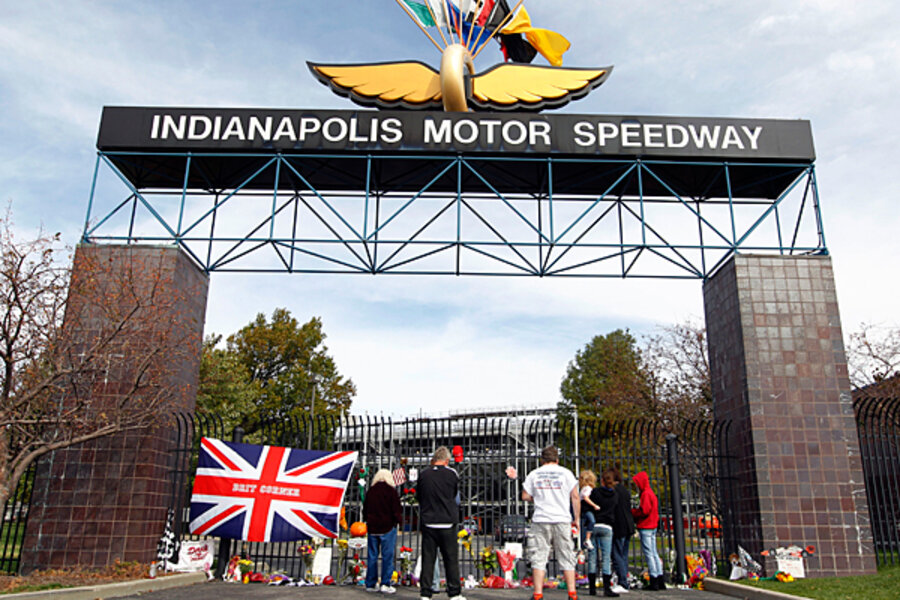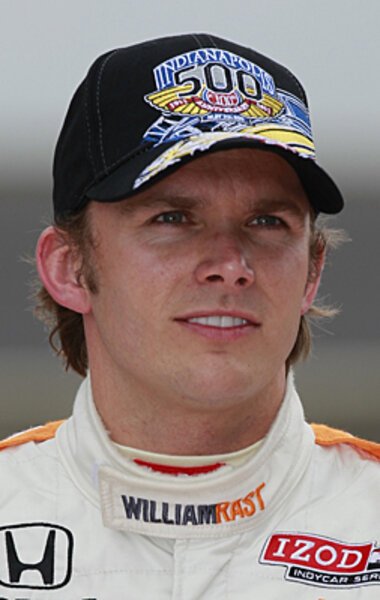Dan Wheldon: Death of IndyCar driver rattles 'fearless' racing culture
Loading...
| Atlanta
Before Dan Wheldon's open-wheeled race car went airborne and crashed into the track fence during a 15-car pileup at an IndyCar Circuit race in Las Vegas Sunday night, the scrappy, popular two-time Indianapolis 500 winner had been chasing a $5 million bonus, payable if he won.
The horrific crash, which killed Mr. Wheldon, shook the motorsport world and is likely to spark safety enhancements over and above those already planned for next year's IndyCar circuit, which includes a completely rebuilt racing car with more safety padding. Sunday night's race was the finale for the the 2011 circuit.
Long before Sunday's crash, IndyCar had helped pioneer major safety improvements that have dramatically reduced the number of deaths in the major motorsports over the past decade, including new, more forgiving track barriers, new head restraints, and, starting next year, a new car, largely tested by Wheldon, with more safety padding and a device to prevent the open-seated cars from going airborne much in the manner of Sunday's brutal crash.
But for many people around the sport, and beyond, Wheldon's death said less about safety mechanics than it did about the nature of open-wheeled racing at the international level, where machismo, bravado, and desperation to win a purse still reign as cars jockey for position with minimal margin for error.
Right before the race, drivers had raised concerns about the extreme speeds being recorded at the Las Vegas track, which has high banks that allow racers to maintain speeds gained on the flats, especially with 34 cars packed onto the oval track. IndyCar Series races are held both on ovals and on streets.
Driver A.J. Allmendinger, who did not race Sunday, told Fox Sports that the accident will likely force a new discussion within IndyCar about safety measures that can be instituted beyond changes to equipment and tracks. That, he said, should mean fewer cars being allowed to race, and some tracks – including the Las Vegas short oval – being scrapped.
"Hopefully, we learn something from this," he said. "First, Dan needs to be remembered before everybody jumps on IndyCar, then there needs to be action. There doesn’t need to be 34 cars; it’s a ticking time bomb. Obviously, with the new car coming in, it needs to be safer, but there are tracks that they don’t need to race at.”
The crash came in Turn 2 on Lap 13, as the field of drivers were gunning their cars in close quarters, in front of what was considered a small crowd of 25,000.
"I said before we tested here, having driven a stock car here, this is not a suitable track," driver Dario Franchitti, who won the season title Sunday by default after the rest of the race was canceled, told the Associated Press. "You’re just stuck there, and people get frustrated and go four wide, and you saw what happened. One small mistake from everybody, and it’s a massive thing."
One driver, Scott Speed, declined an offer to race Sunday, saying the Las Vegas oval was too dangerous, especially given the "aggressive" driving posture taken by international drivers.
“A lot of the drivers racing in open wheel are international and more aggressive,” Mr. Speed told Fox Sports. “I raced with a bunch of those guys and I would consider them fearless, balls-to-the-wall kind of guys. Put those guys on an oval and you add more fuel to the fire.”
Wheldon, a Brit, had twice won the Indy 500, including earlier this year. He was one of the best-known faces of the sport, but had nevertheless failed to get a full-time contract and had only raced three times this year. He was filling in as a commentator and even a newspaper blogger as he sought permanent sponsorship. On Sunday, he had been offered $5 million, half of which would be split with a fan, if he could get from 34th to 1st place, as part of an attempt to draw more people to the IndyCar season finale. "I'll do everything I can to put on a show," he said in his last blog missive for USA Today.
More than 6,500 people have died at motorsports races around the world since 1895. NASCAR hasn't seen a single death after instituting safety changes following the death of racing legend Dale Earnhardt in 2001, and Wheldon's death was the first for IndyCar since 2006.
At the same time, total racing deaths in the US have gone up in the last 10 years, with at least 235 people having died mostly on small, local tracks since Earnhardt's crash, compared with 217 who died at auto races in the 10 years before his death, according to the Charlotte Observer.
For open-wheeled racers, Wheldon's death and injuries to three other racers sparked one potential safety improvement that had little to do with equipment or track selection: self-reflection.
"We need to take care of each other," driver Tony Kanaan told the AP. "We are playing with lives here. We need to give each other room and … we need to tell the guys to use their heads."






